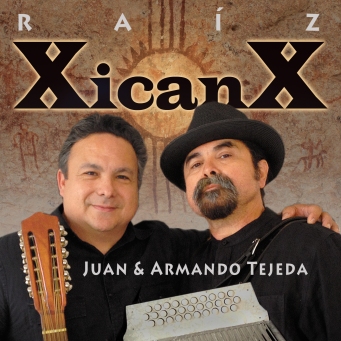
Raíz XicanX by Juan & Armando Tejeda is a collection of 17 love songs to and from la Raza that range from original indigenous cantos and corridos to traditional Conjunto Tejano, to blues, boleros, country, cumbia, rock, and jazz.
Listen to six excerpts from the CD below.
To purchase the hard copy CD via PayPal, click here or on the Buy Now button below. Shipping & Handling is included in the cost:
Purchase individual songs or the entire CD at iTunes here.

Raíz XicanX by Juan Tejeda
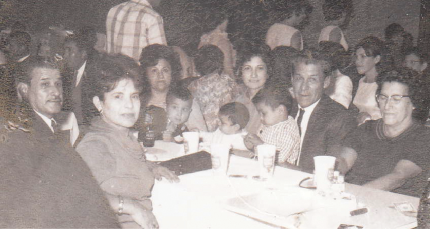 Armando and I are primos hermanos dobles, double first cousins. Our mothers, Lilia Cisneros Tejeda (my mom) and Alicia Cisneros Tejeda (Armando’s mom) are sisters who married two brothers, Rogelio Tejeda (1917-1991), Armando’s father, and my father, Francisco Mariano Tejeda (1919-1987). We are brothers, really. La misma sangre. Our parents and families were very close and lived next to each other most of our early lives after WWII in a working class barrio on the southside of San Antonio, Tejas. Tío Rogelio and Tía Alicia had four boys and one girl (José Rogelio, José Antonio, Roberto, Alice Marie and Armando), and my parents also had four boys and one girl (Frank, Mary Alice, me, Ernesto Raul and Richard). Our fathers and generations of our abuelos and relatives are buried here at the Villa del Carmen Church Cemetery. We are blessed and grateful to still have our mothers in our lives. Mi amá, Lilia, will be 96 years old this November and Tía Alicia turned 94 in June.
Armando and I are primos hermanos dobles, double first cousins. Our mothers, Lilia Cisneros Tejeda (my mom) and Alicia Cisneros Tejeda (Armando’s mom) are sisters who married two brothers, Rogelio Tejeda (1917-1991), Armando’s father, and my father, Francisco Mariano Tejeda (1919-1987). We are brothers, really. La misma sangre. Our parents and families were very close and lived next to each other most of our early lives after WWII in a working class barrio on the southside of San Antonio, Tejas. Tío Rogelio and Tía Alicia had four boys and one girl (José Rogelio, José Antonio, Roberto, Alice Marie and Armando), and my parents also had four boys and one girl (Frank, Mary Alice, me, Ernesto Raul and Richard). Our fathers and generations of our abuelos and relatives are buried here at the Villa del Carmen Church Cemetery. We are blessed and grateful to still have our mothers in our lives. Mi amá, Lilia, will be 96 years old this November and Tía Alicia turned 94 in June.
At 54 years old in 2018, Armando is about ten years younger than I am. I will be 65 this October. We have been performing traditional, and at times not-so-traditional, Tejano Conjunto music with acordeón y bajo sexto for a little over 30 years. I was a student at the University of Texas in Austin during the early-to-mid-70s and heavily involved in the Chicano Civil Rights Movement when I formed the Conjunto Aztlan and was jefe segundo of Xinachtli, a traditional Mexica-Azteca conchero dance group for nine years. Armando and I used to perform occasionally during this time at family gatherings. I returned to San Antonio in 1978 and was hired by the Guadalupe Cultural Arts Center in 1980 where 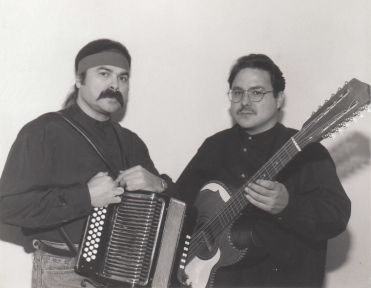 I directed their Xicano Music Program for 18 years until 1998. In 1987, Armando and I began to more formally perform as a duet when we did the music for the play Amor de Hija at the Teatro Guadalupe. Over the years we have performed at public concerts and private parties and conducted educational seminars and presentations on Tejano Conjunto Music all over San Antonio and Texas, and as far away as Nebraska and
I directed their Xicano Music Program for 18 years until 1998. In 1987, Armando and I began to more formally perform as a duet when we did the music for the play Amor de Hija at the Teatro Guadalupe. Over the years we have performed at public concerts and private parties and conducted educational seminars and presentations on Tejano Conjunto Music all over San Antonio and Texas, and as far away as Nebraska and  Wyoming. Armando recorded with us on the first self-titled Conjunto Aztlan CD back in 1998 and has recorded and performed on bajo sexto with some of the greats in Conjunto music including Valerio Longoria, Jesse Borrego Sr., Santiago Jiménez Jr., Chalito Johnson y Los Paisanos, among others. When I left the Guadalupe Cultural Arts Center in 1998, I went back to school and received my Masters in Bicultural Studies from the University of Texas in San Antonio and taught there for a couple of years before I was hired at Palo Alto College in 2002 where I began a Conjunto Music Program and established the Center for Mexican American Studies. I retired in 2016. Armando is a veteran of the U.S. Marine Corps and currently a Lecturer in Education at Texas A&M University San Antonio and a PhD candidate at the University of the Incarnate Word where he is working on his dissertation.
Wyoming. Armando recorded with us on the first self-titled Conjunto Aztlan CD back in 1998 and has recorded and performed on bajo sexto with some of the greats in Conjunto music including Valerio Longoria, Jesse Borrego Sr., Santiago Jiménez Jr., Chalito Johnson y Los Paisanos, among others. When I left the Guadalupe Cultural Arts Center in 1998, I went back to school and received my Masters in Bicultural Studies from the University of Texas in San Antonio and taught there for a couple of years before I was hired at Palo Alto College in 2002 where I began a Conjunto Music Program and established the Center for Mexican American Studies. I retired in 2016. Armando is a veteran of the U.S. Marine Corps and currently a Lecturer in Education at Texas A&M University San Antonio and a PhD candidate at the University of the Incarnate Word where he is working on his dissertation.
Armando and I have been thinking of recording a CD together for many years. We wanted to record our interpretation of the simple music, songs and arrangements we had developed together over the years, primarily as a duet. We began recording this CD in 2015 but were side-tracked for over a year when Mando developed an aneurysm and had brain surgery in 2016. We are thankful to the Creator that he recuperated well, and we resumed our work on this recording in late 2017.
With this CD we wanted to remember, honor and celebrate our Native American/XicanX musical and cultural raíces, our ancestors, and deep ties that we have to this land known as Yanawana/San Antonio, Tejas. We wanted to remember and thank our abuelos and parents who gave us the gift of music. It was my father who took me for my first button accordion lessons with a young Santiago Jiménez Jr. when I was nine years old. My mother bought me my first two-row Hohner button accordion when I was ten. Armando’s mom, Tía Alicia, bought him his first guitar from Sears when he was seven years old. His father, Tío Rogelio, taught him his first chords on the guitar. Tío Rogelio 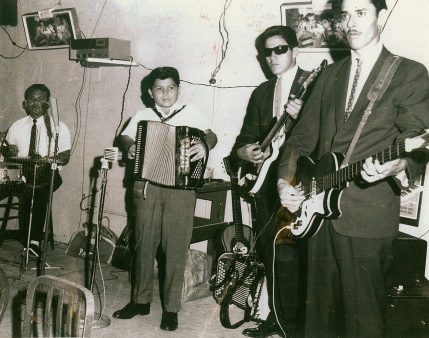 was the main musician of the family and played guitar, bajo sexto and bass. Our parents loved Conjunto music and as children they would sometimes take us to the dances at el Salón de Torres, and later, to El Venadito Nite Club on the deep southside of San Anto where Mando’s brothers, Tony and Bobby, and I played with Santiago Jiménez Jr. y su Conjunto. Afterparties and family celebrations inevitably saw Tío Rogelio and my father pulling out the guitar or bajo sexto and singing songs such as “El Ausente,” or “Los Barrandales del Puente.”
was the main musician of the family and played guitar, bajo sexto and bass. Our parents loved Conjunto music and as children they would sometimes take us to the dances at el Salón de Torres, and later, to El Venadito Nite Club on the deep southside of San Anto where Mando’s brothers, Tony and Bobby, and I played with Santiago Jiménez Jr. y su Conjunto. Afterparties and family celebrations inevitably saw Tío Rogelio and my father pulling out the guitar or bajo sexto and singing songs such as “El Ausente,” or “Los Barrandales del Puente.”
We also wanted to honor, remember and thank those innovative great musicians and stylists that created this original American musical ensemble and style of music that we know as Conjunto Tejano: Santiago Jiménez Sr., Narciso Martínez, Valerio Longoria, Tony De la Rosa, Rubén Vela, Esteban Jordán, Eva Ybarra and many others. Most of these musical legends of our Raza have passed on to the spirit world now, but their musical legacy and influence lives on forever.
The music on this Raíz XicanX CD reflects who we are as a people: Native Americans/Xicanxs, the Indigenous/Mexican people within the U.S. It documents our native history and the racist, brutally violent and genocidal colonization of these lands, first at the hands of the invading Spanish Catholic conquistadores, then Mexico, Texas and the U.S. We didn’t cross these borders, as the saying goes, but definitely the governments and borders crossed us. At the same time, our people and our music have resisted, mixed, survived, adapted and transcended these borders by creating a uniquely American culture and musical mestizaje with original ensembles, such as the Conjunto Tejano, that sing the songs and tell the stories of our Raza XicanX.
 Raíz XicanX is a concept CD that chronicles the musical history of our people in all of its rich diversity, from an indigenous canto with drum and flutes, to corridos, to traditional Conjunto Tejano and African-based blues, boleros, cumbia, country, rock, jazz and beyond. These are some of the love songs of our Raza. Canciones de amor y dolor, love and loss. The music on this CD begins with an original indigenous love song that I wrote for my daughter, Maya Quetzalli, and continues with two corridos that my father wrote during his military service in the U.S. Army and World War II. Next comes a section of four instrumental (button accordion, bajo sexto and bass) pieces and rhythms of early, classic Conjunto Tejano music. We follow this with our full Conjunto (with drums) arrangements of three popular songs that were covered by Valerio Longoria, Tony De la Rosa and Rubén Vela. We also include our Conjunto bluesy version of an old goodbye ballad that my mother and father used to sing together, “La Barca de Oro,” which transitions the CD to a blues/jazz section that includes tinges of rock and country with our arrangement of “Barbacoa Blues” by the great Chicano bluesman, Randy Garibay, and two of my original songs: a string version of “I Couldn’t Sleep Last Night,” and a keyboards and horn arrangement of “Forgive Me for Fallin’.” The final section of the CD includes a cumbia Colombiana, “El Canoero,” and a popular Mexican folk song, “La Llorona,” that is over 8 minutes long. The last tune is an original song I wrote for my daughter Zitlalli Aztlan Libre. It is an Indigenous/Conjunto fusion love song for my daughter, and for all children, in the hope that they will inherit a new and better world, one based on love, justicia, respect, harmonía y paz.
Raíz XicanX is a concept CD that chronicles the musical history of our people in all of its rich diversity, from an indigenous canto with drum and flutes, to corridos, to traditional Conjunto Tejano and African-based blues, boleros, cumbia, country, rock, jazz and beyond. These are some of the love songs of our Raza. Canciones de amor y dolor, love and loss. The music on this CD begins with an original indigenous love song that I wrote for my daughter, Maya Quetzalli, and continues with two corridos that my father wrote during his military service in the U.S. Army and World War II. Next comes a section of four instrumental (button accordion, bajo sexto and bass) pieces and rhythms of early, classic Conjunto Tejano music. We follow this with our full Conjunto (with drums) arrangements of three popular songs that were covered by Valerio Longoria, Tony De la Rosa and Rubén Vela. We also include our Conjunto bluesy version of an old goodbye ballad that my mother and father used to sing together, “La Barca de Oro,” which transitions the CD to a blues/jazz section that includes tinges of rock and country with our arrangement of “Barbacoa Blues” by the great Chicano bluesman, Randy Garibay, and two of my original songs: a string version of “I Couldn’t Sleep Last Night,” and a keyboards and horn arrangement of “Forgive Me for Fallin’.” The final section of the CD includes a cumbia Colombiana, “El Canoero,” and a popular Mexican folk song, “La Llorona,” that is over 8 minutes long. The last tune is an original song I wrote for my daughter Zitlalli Aztlan Libre. It is an Indigenous/Conjunto fusion love song for my daughter, and for all children, in the hope that they will inherit a new and better world, one based on love, justicia, respect, harmonía y paz.
We thank the Creator/Great Spirit, Yauna’k Akio, Ometeotl, for the gifts of creation, music and this CD. We thank all of the músicos, familia and camaradas who contributed to Raíz XicanX, and we dedicate these humilde love songs to our native abuelxs and musical ancestors, to our fathers, Francisco Mariano and Rogelio Tejeda, to our mothers, Lilia and Alicia Cisneros Tejeda, to all of our familia, and all of our children and their children’s children for generations to come.
All Our Relations/Nawaso’l Ment Yawet.
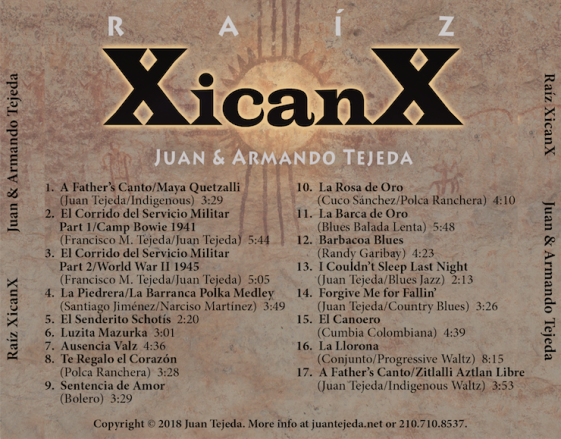
Musicians/Credits
Juan Tejeda—Button Accordion, Vocals, Vocal Arrangements, Flute, and Drums on “Te Regalo el Corazón,” “La Rosa de Oro” and “A Father’s Canto/Zitlalli Aztlan Libre.”
Armando Tejeda—Bajo Sexto and Bass on all tunes except for the bass on “I Couldn’t Sleep Last Night,” and “Forgive Me for Fallin’,” and Vocals.
Armando Aussenac—Drums on all other tunes except those with Juan Tejeda.
Joe Reyes—Lead Guitar on “I Couldn’t Sleep Last Night” and “Forgive Me for Fallin’.”
Henry Brun—Bongós on “Sentencia de Amor” and “La Llorona.” Congas/Hand Percussion on “El Canoero.”
George Prado—Acoustic Bass on “I Couldn’t Sleep Last Night.”
The following guest musicians recorded on “Forgive Me for Fallin’”:
Arturo “Sauce” González—Keyboards
Al Gómez—Trumpet and Horn Arrangement
Jay Fort—Saxophone
Pete Ojeda—Bass
Urban Urbano—Drums
Isaac Álvarez Cárdenas—Indigenous drum and eagle bone whistle on “A Father’s Canto/Maya Quetzalli.”
Gracias to Max Baca for lending Armando his bajo sexto on “La Barca de Oro,” and to Karla Aguilar for lending us her huehuetl for “A Father’s Canto/Zitlalli Aztlan Libre.”
All tracks recorded by Joe Treviño at Blue Cat Studio in San Antonio, Tejas.
All tracks mixed by Juan and Armando Tejeda with Joe Treviño.
Mastered by Kurt Wipfli at WIPTRAX Studios, San Antonio, TX, USA.
Cover and other design work by Clemente Guzmán III.
Additional CD design work and Juan Tejeda website by Anisa Onofre.
This Raíz XicanX Musical CD Project is supported in part by the National Association of Latino Arts and Cultures, Southwest Airlines, and the City of San Antonio Department of Arts & Culture through a grant from the NALAC Fund for the Arts Grant Program.



Carnalxs:
Since the release of our new CD, Raiz XicanX/Juan & Armando Tejeda, on November 17, many familia and friends have asked me what the X’s in XicanX mean. For me, an old vato from San Anto who developed his political and cultural conciencia and identity at the University of Texas in Austin when I went to school there in 1972 and took my first Chicano History course, then became heavily involved in the Chicano Civil Rights Movement, the X means many things. Without getting into a super-long historical/linguistic/cultural explanation of the word, the simplest way I can tell you is that there is an evolution of the word from Mexica, Mexicano, Chicano/Xicano, to XicanX. The first X in XicanX comes from MeXicano. The last X is a relatively new linguistic phenomena that is becoming more popular in usage for the following reasons: In the Spanish language there is gender identification at the end of a word by using the letter a for female, and o for male, as in Chicana and Chicano. Over the years, the Chicano Movement has used different ways of writing Chicano/Xicano to be more inclusive of both females and males, as in Chicana/Chicano, Xicana/o, Chican@, and Chicanx/Xicanx.
The X at the end of XicanX also goes against the traditional patriarchal, racist, sexist and homophobic systems built on male/female gender binary roles, and includes our sisters and brothers from the LGBTQIA community that don’t abide by the traditional gender roles.
Ultimately, the XicanX Movement has been and continues to be about justice, equality, respect and liberation of all peoples and nations, and the return to our ancient and future ties to our roots, this land, and our native/indigenous identity and spirituality. Our ancestors and elders have a lot to teach us about living in peace and harmony with all human beings, our sacred mother earth, and all our relations.
Besides, I like that Malcolm X used the X to represent the unknown name of his African ancestors and their culture that had been lost during slavery. And so it is with our indigenous ancestors and names. I also like the X because it is a symbol of the nahuiollin, four movement, which is the symbol we are currently living under in the 5th Sun, the sun of war and conscience. As our Mayan/Toltec/Aztec prophecy tells us, this sun will also be destroyed and we will enter into the 6th sun, nahuicoatl, four serpent, which will be the sun of justice. Neta.
In tlanextia in tonatiuh/Que su sol sea brillante.
In lak’ ech/Tu eres mi otro yo.
All our relations/Nawaso’l ment yawet.
Juan Tejeda
LikeLike
So, finally got our new CD, Raiz XicanX/Juan & Armando Tejeda, on all of the worldwide streaming services. You can now listen to all 17 songs on the CD on your favorite streaming service. Here’s the link to Spotify: https://open.spotify.com/album/1uRAX7kzWZIsMoZW42Dmxv…
You can get more information, listen to music, and purchase Raiz XicanX, as well as two Conjunto Aztlan CD’s, on my website at juantejeda.net
Hope you enjoy it. Tlazo for your support. Juan
LikeLike